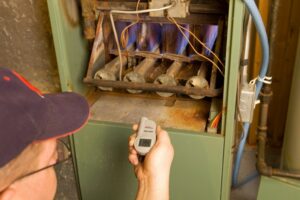Using a gas furnace is one of the most common ways to provide heat to a home during the winter. For the most part, you depend on your natural gas furnace to work safely for you if you remember to schedule an annual tune-up and inspection for it with HVAC professionals.
Still, a gas furnace can become hazardous, and one of the ways is because of a cracked heat exchanger. In this post, we’ll explain this furnace problem and what to do about it. We’re here to help with any furnace services in Greenville, SC that you need.
What Is a Cracked Heat Exchanger?
The heat exchanger is a crucial component in your gas furnace. It’s responsible for transferring heat from the combustion chamber to the air that circulates throughout your home. Over time, an exchanger can develop cracks due to age, corrosion, poor exhaust ventilation, or neglected maintenance. When a heat exchanger is cracked, it can allow the toxic combustion gases inside to escape.
Dangers of a Cracked Heat Exchanger
Carbon Monoxide Poisoning
One of the most significant dangers associated with a cracked heat exchanger is the potential for carbon monoxide leaks. Carbon monoxide is a colorless, odorless, and tasteless gas that can be fatal in high concentrations. A cracked heat exchanger can allow this deadly gas to escape into your home, putting you and your family at risk.
Fire Hazard
A cracked heat exchanger can also increase the risk of a fire in your furnace. The compromised integrity of the exchanger may lead to overheating, causing adjacent components to ignite. This not only endangers your home but can result in irreparable damage to the furnace.
Signs of a Cracked Heat Exchanger
Detecting a cracked heat exchanger early is essential for preventing serious safety issues. Look out for the following signs:
Strange Odors
If you notice unusual odors, especially a sweet smell or a rotten-egg stench, it could be a sign of a cracked heat exchanger releasing gases into your home.
Visible Cracks or Corrosion
Regularly inspect your furnace for visible cracks or signs of corrosion on the heat exchanger. This requires professional inspection during maintenance, as cracks may be challenging to spot without specialized equipment.
Fluctuating Flame Color
During normal operation, the flames in your furnace should burn blue. If you observe a yellow or flickering flame, it could indicate a problem with the heat exchanger.
What to Do If You Suspect a Cracked Heat Exchanger
Shut Off the Furnace
If you suspect a cracked heat exchanger, turn off your furnace immediately at the furnace switch and do not use it until the issue is resolved.
Ventilate Your Home
Open windows and doors to ventilate your home, especially if you suspect a carbon monoxide leak. Leave the premises.
Contact HVAC Professionals
Do not attempt to repair a cracked heat exchanger yourself. Contact our qualified HVAC professionals to inspect and address the issue. We have the expertise and equipment to assess the condition of the heat exchanger and recommend the best solution. In some cases, we can replace the heat exchanger. If the furnace is an older one, we may recommend a full furnace replacement.
Rely on Carolina Climate Control for your furnace needs. The Moose Is Loose in Your Neighborhood!

